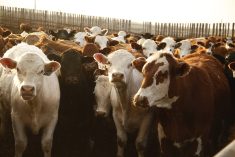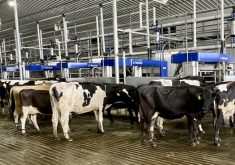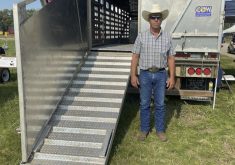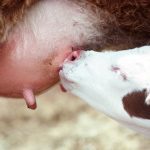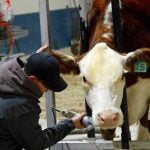After an inordinately high number of lice reports in 2017 and 2018, Solvet dug deep into itchy cattle numbers.
The company found it’s not as lousy a situation as first thought but potentially due to various mites, vitamin and mineral deficiencies, and environmental sensitivities or impacts.
Despite a high number of reports, investigations showed most cattle had no signs of lice. Veterinarians were left wondering what caused the discomfort and why reports dropped back to 2016 numbers by 2019.
Read Also

Jennifer Hayes appointed for second term as the Chairperson of the Canadian Dairy Commission
Jennifer Hayes has been re-appointed as Chairperson of the Canadian Dairy Commission by Heath MacDonald, Minister of Agriculture and Agri-Food.
Why it matters: Itching can affect livestock health if they spend time dealing with the irritation versus eating, resting or socializing.
Dr. Denis Nagle, consulting veterinarian at Solvet and Alberta Veterinary Laboratories Ltd. (Avetlabs), said he began fielding hundreds of complaints from producers and veterinarians regarding itchy cattle in 2017. The numbers remained high in 2018, prompting an investigation into potential application error or treatment resistance.
“Complaints started to roll in, and it just kept building and building. The January prior to that in 2016, there virtually was nothing,” said Nagle at the Grey Bruce Farmers’ Week Beef Day last month. “In all of Western Canada, we had five complaints, and most of those were application errors.”
Western Canada has sucking and biting lice, with the latter causing the most irritation and far harder to treat because injectable ivermectin is ineffective.
“These lice feed on debris and skin secretions, and there’s not enough ivermectin in those products to kill the louse,” he said. “Because there’s no extended effect, the permethrins don’t kill the unhatched eggs and, as those eggs hatch in seven to 10 days, you have lice infections again. So, you have to treat multiple times with permethrins to kill biting lice.”
Sucking lice are the most prevalent in herd investigations and infest the top line, tail head and face. Nagle said their life cycle is about a month long, and longer if the weather is cold.
“The ivermectin doesn’t kill the unhatched (sucking lice) eggs, but it does have an extended period of activity,” he said. “It will catch those eggs that have hatched the first time, and then, because they consume blood and there’s ivermectin in the blood, it will kill them.”
Initially, when the reports of itchy cattle spiked, Nagle said the focus was on application failures with the hypothesis of ill-timing, cold weather that turned the product to ineffective gel, or misapplication.
“Lice aren’t easy to see. They’re very small. You need good lighting, and I need a magnifying glass. In any herd, you won’t find lice on all the cattle, even if they’re heavily infested, so you have to run a lot through,” he said.
Producers usually think itchy cattle have lice, but “we know that that’s not the case.”
And it wasn’t the case for most of the herds inspected for lice. So why are the cows scratching?
Nagle suspects mange mites, straw mites, vitamin and mineral deficiencies or environmental factors.
Sarcoptic mange, commonly known as scabies, is rarely seen and is tough to diagnose, said Nagle, but chorioptic mange is becoming more prevalent in Canada. It can cause severe itching and is difficult to diagnose despite mange-like hair loss patterns.
“Chorioptic mange mites can live off the host for a time. They can be in the bedding, so they’re easy to transmit from one to the other,” he said.
“And they have to come into contact with the (pesticide) product, whether it’s permethrin or ivermectin, because they consume surface skin and don’t tend to get up to the backline where you put pour-on products.”
The mites are equally challenging to diagnose and more complicated to treat than lice because the producer must apply the product between the hind legs, which isn’t feasible on a large scale.
Nagle said chorioptic mange is a high-ranking suspect in the itchy cow phenomena and appears to affect bulls more than cows.
Straw mites in loose or baled straw and hay also cause severe itching and are tough to diagnose because they move onto the host, bite, and return to the bedding.
“People that have hauled small square bales without a shirt will probably have experienced these small itchy spots all over,” said Nagle. Straw mites are the culprits and are more problematic in wet years.
The spike in itchy cattle coincided with reduced feed quality due to an extended drought stretching from east of Winnipeg to north of Fort St. John in 2016 and a shortage of Vitamin A following a fire in a production plant.
“I’m very suspicious that there is an underlying nutritional component to this. I don’t know what that is,” Nagle said. “On some of the herds I’ve investigated that I couldn’t find lice, I did check for Vitamin A and E. It turns out they were low or deficient in both.”
He said feed and pasture quality was better in 2018 and itchy cattle numbers dropped to a typical level in the following year. There is also a pattern where the itch on cattle clears up once they hit green grass in May, regardless of previous louse treatments.
In addition, calves don’t suffer from irritation, pointing toward a nutritional deficiency correlation. Nagle said premature shedding in February is also tied to a dietary deficiency.
“Those cows (we look at) have very dry coats. There will be scurf that’s millimetres deep all over these cattle.”
When considering environmental impacts like frostbite, solar hypersensitivities and photosensitivity, the potential triggers for cattle itch increase.
“We (Solvet/Avetlabs) have plans in place to investigate these problems,” Nagle said. “We plan on searching out these herds that do have itchy cows, looking for lice and doing some journal testing to see if the lice are actually causing the itching or if it’s something else.”





